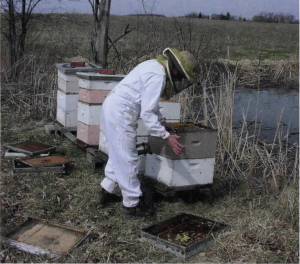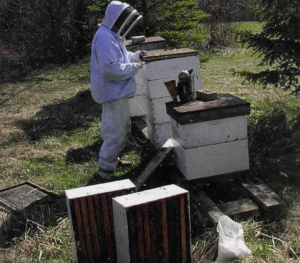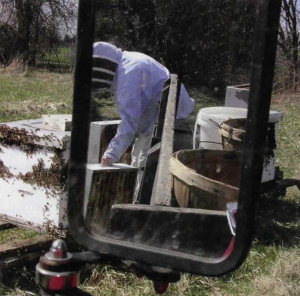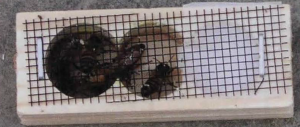By: Miles Sarvis-Wilburn
This article originally appeared in the Spring 2018 issue of BEEKeeping Your First Three Years
Colony Collapse Disorder, Varroa, foulbrood, wax moths, chalkbrood – the list goes on and on. These are not problems of the honey bee. On the contrary, they are problems of the beekeeper, though this fact is rarely noticed. Instead, millions of dollars are dedicated to research, experimentation, scientific studies, and lobbying. We read of new treatment solutions for Varroa, learn about probiotics and antibiotics to be administered, and speculate as to how to improve that mysterious substance: honey comb. Such a paradigm is not wrong or bad, but it is dominant and mostly unchallenged. I wish to bring a preliminary critique forward regarding how we as beekeepers view ourselves in relation to the ailments of our subject, the honey bee.
At first glance this may seem like a mundane and asinine topic, but I believe it is paramount to our dialogue on beekeeping, agriculture, and the health of human beings. If we cannot adequately theorize our situation as apiculturists, how can we expect to accurately assess and address the practice at hand? This is to say that if we do not know who we are, how can we know what we are doing? So who are we and what are we doing?
We are beekeepers: people who host colonies of honey bees in manufactured boxes, attempt to manage them, and harvest the byproducts of their existence. This could be called a symbiotic relationship in that we provide the bees with a supposedly safe home and, in return, we harvest what honey and wax they do not require to overwinter. When we look at our honey bees, we want them to be healthy and happy, foraging for miles upon high quality nectar and pollen. We want them to live in a clean and tidy environment, with their young emerging strong and their mother laying well. We want the world for them and become disturbed by the seemingly endless stream of problems impacting this world.
A common human response is to judge the situation in the following manner: honey bees should behave a certain way, they are not and the cause appears to be X, thus we need to eliminate or reduce X. There are three assumptions at play in this simple judgement: (1) honey bees ought to behave a certain way, or that their behavior is readily indicative of health; (2) the cause of this change in behavior can be isolated and identified; (3) if the first two assumptions are true, eliminating or reducing the cause is a solution. Should any of these assumptions prove to be false, we are in danger of creating new problems or furthering old ones. Indeed, the farther down this road we travel the less we are able to parse actual problems from ones we may have created.
We can begin to address this issue by looking at a classic philosophical item known as the Archimedean point. Archimedes of Syracuse (c. 287 BC – 212 BC) was a Greek mathematician, philosopher, scientist and engineer. While speculating on the power of the lever as an engineering tool, he is quoted as having said: “Give me the place to stand, and I shall move the earth.” This phrase, in turn, led to the idea of a hypothetical point of view where someone can objectively see without obstruction. We could call this a ‘God’s eye’ perspective. Archimedes of course could never leave Earth to find his point of leverage; his claim was hypothetical and used to forward his argument regarding engineering. But the idea of discovering a point of observation, pure and untainted by bias or subjective interpretation, is a long-standing one.
Let us bring this back to beekeeping by taking a simple example: inspecting the hive. Hive inspections are important aspects of modem beekeeping and most beekeepers – generally speaking – advocate for an inspection around every two weeks. Inspections seem vital for understanding the conditions within the hive, the health of the colony, and so forth. But note how, no matter the care and delicacy, the theory of hive inspections involves an implicit reliance upon the Archimedean point. After all, it is impossible to inspect the combs without opening the hive. And we know that honey bees seal the inside of their home with propolis, keeping it as clean and contaminant-free as possible, and that they maintain the temperature, moisture levels, and air flow within. Thus, opening the hive is akin to total internal ecosystem destabilization. Whatever may be in the air (particulates, pesticides, pathogens) floods the interior of the hive, contaminating every surface. No matter how docile the bees appear or how much smoke is used to force them to gorge on honey reserves, their stress level rises.
Stress in human beings causes the sympathetic nervous system to activate (the so-called “fight or flight” reflex): heart rate increases, bronchial tubes and pupils dilate, parts of digestion are stopped, and more glycogen is converted to glucose. Many new studies are looking into the impacts of chronic stress and excessive activation of the sympathetic nervous system, leading to new classifications of diseases and illnesses such as adrenal fatigue. Little research has been made into whether honey bees undergo similar stress responses, and less still into how such responses affect the bee over time. The question remains: what is the effect on the colony of disrupting the internal ecosystem of the hive?
The reason why I ask this question is because it returns us to a point of solid ground, outside the realm of a supposed Archimedean point. When we open the hive to inspect the colony, we are altering the characteristics of the very thing we are inspecting and cannot maintain a truly objective perspective. If we were to take this seriously, we would have to account for the environmental changes made by our disruption, something that is excessively complex. We must ask ourselves: are we ever witnessing anything other than stress behavior when we inspect a hive? I think the case could be made that we are not, that our understanding of ‘regular bee behavior’ in the hive is stress behavior caused by our intersection into an otherwise private world. If this is the case, then the conclusions drawn from every hive inspection are skewed by our implicit assumptions.
My point here is not to demand that beekeepers cease inspecting hives, but to ask that we begin a critical look regarding our relationship to our -keeping. How is it that we keep our bees? This is not a superficial question, but a serious and necessary one. We must account for two things: (1) the lack of an Archimedean point and the effects of our actions upon the colony; (2) the context of our very -keeping. I have expanded upon the first point already and the second is a much larger topic that we can only begin to discuss in the context of this paper.
We must ask ourselves: what is the context of our beekeeping? This is to say, why am I keeping these bees? I think it is safe to assume that – beyond love and care for these creatures – most keep for some sort of profit, be it pollination services or honey sales. When a beekeeper looks at the health of their bees it is always contextualized by the reason for this keeping. For many, unhealthy bees mean less money. I do not wish this to be a critique of profit, but simply to note that this context is inseparable from the act of beekeeping. In other words, honey bees have problems in-so-far as we need them for particular reasons. We keep them for profit, for vital pollination services, and for their honey. Their problems are not, as we state casually, problems of the honey bee, but rather they are problems in that they jeopardize our needs. No beekeeper cared that Varroa has lived with feral bees for centuries. It is not until we use the bees that we believe them to have problems; thus, it is we who have the problem of Varroa, not the honey bee.
This argument is supported by the fact that, for centuries prior to modem industrial beekeeping, honey bees had few of the problems that we identify today. For example, Varroa was “discovered” in 1904. Does this mean it spontaneously emerged at this point in history? Doubtful. It is far more likely that in the preceding fifty years (Langstroth patented his hive in 1852) the territory and form of apiculture was changed so dramatically that the conditions for Varroa to flourish were created. The current and ongoing failure of honey bees to manage threats is not a problem of the bees themselves, the quality of queens, the vitality of genetic stock, and so forth. It is a human problem and it lives within us. It is born and bred through our practices and our actions. If human beings went extinct tomorrow the honey bee would be fine, but can we say the opposite?











